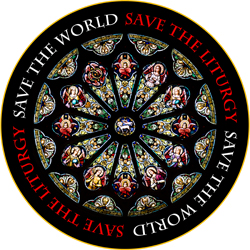

Very interesting piece by Ann Arco from some months past in the UK's "Catholic Herald." It reminded me of reading some Victorian novel whose name escapes me at the moment, which featured a heroine who had to live with, or eventually die from, I think I recall, the pain and shame of loving a Catholic, what with Catholicism's grisly worship of bits of dead people ;oP
Well, it is hard to convey our beliefs about this to non-Catholics.
It also reminded me of the great sadness I have felt when coming across holy cards, crucifixes, etc., items almost surely blessed, desecrated in bins of mismatched mittens and old tupperware at thrift stores. I always feel obliged to ransom them...
The hand-sized brass crucifix I found rummaging through boxes at home appears to be a reliquary. I was in search of a replacement rosary among my great-grandmother's things when I discovered it. My generation is, on the whole, fairly unused to devotional objects except in churches, so it took me a few hours to work out what it was.
A twist of the little round screw at the bottom opened it up to show a wealth of relics. Nothing gruesome, just seven little gold paper filigree flowers each covered with another little piece of paper bearing a saint's name. Unfortunately these are very faded, but I can work out "Adrian", "Bonifaz", "Agatl" and "Pius". In the middle, a quilled Sacred Heart nestles; the crown of thorns is made either of hair or thread. On the back of the crucifix there appears a pictorial meditation on the crucifixion: the gaming dice, Christ's clothes, a ladder and a scourge, the Sacred Heart and the three nails. I think it is late 19th or early 20th century.
Relics can be a taboo subject. Some people hate talking about them. There is something that feels very un-21st century about keeping bones or fabric connected to a person who has long been dead and then venerating it. For some, it is one of the Catholic Church's embarrassing secrets, a practice that should have been relegated to a drawer in the Pitt-Rivers Museum in Oxford to keep the witch in the silver bottle and the shrunken heads company.
And yet what agnostic person has not at some point treasured a memento, a card signed by a particularly famous singer or a jersey which belonged to a footballer or shorts belonging to Mohammad Ali. These things are apart and removed from daily life, assigned a special meaning. And yet - to argue this is dangerous - because it brings one to the inevitable question: how are these relics different from the relics of the holy people whom we venerate in the Church and ask to intercede for us?
Before you get angry, pause. These are merely questions that a weak defence of Catholic thought brings forward: there is no way of presenting a strong argument about Christian teaching without Christ and through him the possibility of salvation. In the current "dictatorship of relativism" Christianity has, in the popular consciousness, been reduced to one logical system among many - which makes it very difficult to argue any Christian point without the premise of Christ.




No comments:
Post a Comment